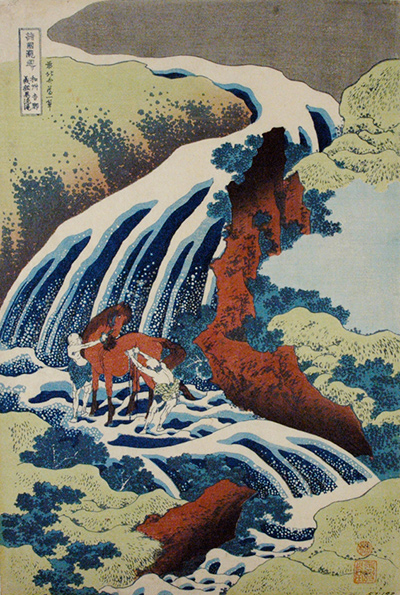Hokusai
Yoshino Waterfalls where Yoshitsune Washed his Horse
Hokusai is one of the most respected artists in the history of Japanese artists.He was very famous in the 1820s. At this time almost everybody now who he was. He’s most famous for his Thirty-six views of most Fuji. His success leads him to make an another collection called A tour of Japanese waterfalls.
For this collection, Hokusai created The Yoshino Waterfall where Yoshitsune washed his horse. It was in Yamato province. The scenery is related to a very famous Japanese tale. The legend goes that a warrior called Minamoto no Yoshitsune once washed his Steed at the river. It is said that he was hiding from his enemies just around waterfalls. The wood print shows the relationship between nature, man and animals, in this case, the horse. In the art created by Hokusai, The background shows a waterfall that runs through a valley of huge trees and man and his huge horse strategically place in the art. The waterfall, however, is the centre of attraction at a first glance.
There are unanswered questions most people ask and that is why he showed two men cleaning the horse and not the strong warrior? What some people may not know about this iconic artist is that he reportedly changed his name more than 30 times. People always gave him nicknames inspired by his unique art. He also started getting his fame when he was almost 70 and he died at 88. When listing the best landscapes ever created Hokusai has to come up. Hokusai was an artist who connected with his art at a unique level. He kept on changing homes. His art is so unique and was the first Japanese artist to concentrate on water as a design for a complete water themed collection.
He made it look and feel so natural. Even though the mountain Fuji views were more famous among people the Yoshino waterfalls are considered by experts his most genius works, Each waterfall is done to perfection and together they are considered masterpieces. You can just stare at the art for minutes trying to understand the artist it’s because of all his art demand attention on their own rights.
